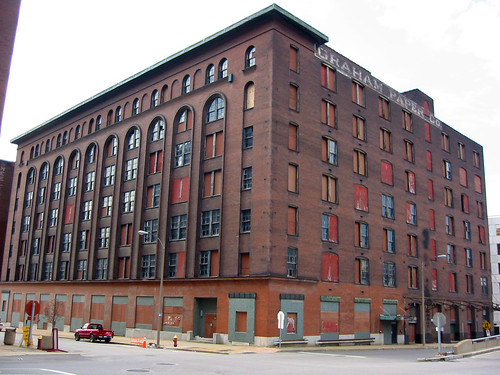
Last week Kevin McGowan applied for a permit demolish Cupples Building #7 saying "he had not choice". Whether he gets a demolition permit will be decided by the Preservation Board on Monday, November 28th, the same night that the fate of the Pevely Dairy will be decided.
There are however other choices besides demolition for Cupples 7. McGowan says that it would be $2 million cheaper to demolish the building than to stabilize it. As someone who works on historic renovation projects for a living, I understand that fully stabilizing the collapsing interior structure would be an expensive endeavor. There is however an alternative that would be significantly less costly than fully re-building the interior timber structure, which is something that should eventually be done as part of the building's redevelopment.
Erecting structural steel bracing on the exterior is something that is often done to stabilize unreinforced masonry facades. On Boston's Russia Wharf the facades of two warehouses were braced while the interior of the buildings were dismantled to make way for a new hi-rise development that incorporates the facades. In the case of Cupples 7, the four exterior masonry walls would be braced and the collapsing interior left as-is, to be stabilized in the future.
Another view of Russia Wharf showing that the scale of the facades is similar to that of Cupples 7. While the cost of this type of bracing would not be chump change, neither would demolition of a massive masonry building. In 2001, according to City records, the unfortunate demolition of another Cupples warehouse (#4) across the street at 10th & Spruce cost $147,760.00. Cupples 7 is at least 1 1/2 times the size of the demolished warehouse and with 10 years of inflation, the cost of demolition for Cupples 7 could be at least twice as much. It should be noted that demolition of the Cupples #4 building was done under the auspices that the building was "structurally unsound" AND would be replaced with a similar scaled office building instead of the parking lot that eventually replaced it.
The exterior walls of the United Methodist Church in Burlington, Iowa were braced after a devastating fire gutted the building. The congregation plans to re-build and expand into an adjacent vacant downtown department store.
Some might argue that bracing the facades of Cupples 7 would render portions of Spruce and 11th Streets as well as sidewalks unusable for years.
This does not necessarily need to be the case as with this example in Memphis (photo by Cathy Jones). The sidewalk is fully usable and there are even temporary displays in the storefronts! In Washington DC, where this technique has been used many times for various projects, the exterior of the former Gales School was structurally braced while awaiting renovation.
While this method may not be a familiar sight in St. Louis, it is a proven way to preserve at least the exterior of historic structures that otherwise would be lost forever. In the case of Cupples 7, while much of the interior is crumbling, you might be surprised how it is possible to save portions of the timber that remain and rebuild what is collapsed.

My first loft project was a building that had suffered what would appear to be catastrophic damage but was resurrected into the M-Lofts, which consists of 40 apartments and commercial space in Lafayette Square. In 1999, the former factory building of the International Shoe Company had seen better days. Almost 30% of the floors of the building were collapsed in the basement, and about 80% of the roof structure had fallen to the floor below.


Portions of the interior structure that had collapsed were carefully cut away and removed, then re-building began from the first floor up. All of the interior rebuilding was eligible for Missouri and Federal Historic Tax Credits because it was a restoration of existing building elements. This made what otherwise would not have been affordable workable for the projects proforma. In the case of Cupples 7, which has a larger floor plate, planning an atrium in one of the collapsed areas could further reduce the cost of re-building the interior structure.

 Massive new timbers replicating the originals were imported from Canada
Massive new timbers replicating the originals were imported from Canada
The completed building shows how something that looks insurmountable can be accomplished successfully. If Kevin McGowan is not up to the task of rebuilding Cupples Building 7, then he should sell the building to someone who is willing to do so. In the mean time, structurally bracing the walls from the exterior is the best solution for stabilization so that this National Register landmark can be preserved for the future.
McGowan said himself that "millions of people walk by that building every year going those Cardinals games, going to the hockey games, going to the various courthouses, even living across the street and next to the building in apartment buildings", which is all the more reason that Cupples 7 should not become yet another giant vacant lot like the Ballpark Village site.









What is wrong with people in st. Louis that they don't appreciate and see the value of these older buildings? Thanks for fighting the fight to keep them standing!
ReplyDeleteyou're amazing, Paul! please make sure that McGowan and the preservation board see this!!!
ReplyDeletePaul, this is an excellent blog post that shows the dangers involved and the solutions to preserving historic structures like Cupples 7. Keep up the good work!
ReplyDelete